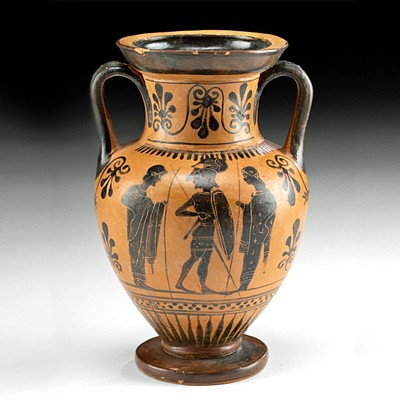Ancient Turkish / Urartian Bronze Armor Plates, 10 pcs
Lot 88
About Seller
Artemis Fine Arts
686 S Taylor Ave, Ste 106
Louisville, CO 80027
United States
Selling antiquities, ancient and ethnographic art online since 1993, Artemis Gallery specializes in Classical Antiquities (Egyptian, Greek, Roman, Near Eastern), Asian, Pre-Columbian, African / Tribal / Oceanographic art. Our extensive inventory includes pottery, stone, metal, wood, glass and textil...Read more
Categories
Estimate:
$5,000 - $7,500
Absentee vs Live bid
Two ways to bid:
- Leave a max absentee bid and the platform will bid on your behalf up to your maximum bid during the live auction.
- Bid live during the auction and your bids will be submitted real-time to the auctioneer.
Bid Increments
| Price | Bid Increment |
|---|---|
| $0 | $25 |
| $300 | $50 |
| $1,000 | $100 |
| $2,000 | $250 |
| $5,000 | $500 |
| $10,000 | $1,000 |
| $20,000 | $2,500 |
| $50,000 | $5,000 |
| $100,000 | $10,000 |
| $200,000 | $20,000 |
About Auction
By Artemis Fine Arts
Mar 9, 2023
Set Reminder
2023-03-09 10:00:00
2023-03-09 10:00:00
America/New_York
Bidsquare
Bidsquare : Exceptional Ancient, Ethnographic, & Fine Art
https://www.bidsquare.com/auctions/artemis-gallery/exceptional-ancient-ethnographic-fine-art-12354
Artemis Fine Arts info@artemisgallery.com
Artemis Fine Arts info@artemisgallery.com
- Lot Description
**Originally Listed At $3500**
Ancient Near East, Eastern Turkey, Iran, and Armenia, Urartu culture, Iron Age, ca. 7th century BCE. An incredibly rare collection of bronze armor plates from the ancient Near East Urartu culture. The triangular panels may have been shoulder guards- encircling the wearer's neck and providing protection with the wing like protrusions - which could have also signified rank. The surfaces of several panels are etched with geometric motifs and may have been retouched / enhanced in modern times with ibex rams, grape clusters, and figures wearing the iconic conical helmets associated with Urartu. It is possible the pair of panels with an angled tips formed ear / cheek plate covers that would have attached to a similar helmet. Multiple pieces of armor from this culture are exceedingly scarce! Size of large shoulder plates: 13.5" L x 9.75" W (34.3 cm x 24.8 cm)
The civilization of Urartu (also known as the Kingdom of Ararat or the Kingdom of Van) was one of several states that arose following the destruction of the Hittite state in approximately 1200 BCE. Others included Tabal, Phrygia, and Lydia - each one possessed its own distinct language, religion, ethnicity, and visual culture. According to the Metropolitan Museum of Art Heilbrunn essay, "In their inscriptions, the Assyrians of Mesopotamia refer to the Urartians as their northern enemies from the eleventh to the seventh centuries B.C. However, the earliest known Urartian written document, a rock inscription at Van (ancient Tushpa), records the earliest reference to the state. There it says that Urartu was ruled by a king named Sarduri (r. ca. 840–830 B.C.), and mentions a male deity, Haldi, the supreme god throughout Urartian history." Urartu had such skill with bronze work that the Assyrians would take their finished metal objects whenever they could, through trade, warfare, or plunder. For example, Assyrian king Sargon II listed 305,000 bronze daggers as the plunder from a successful campaign in Urartu.
PLEASE NOTE: Due to recent increases of shipments being seized by Australian & German customs (even for items with pre-UNESCO provenance), we will no longer ship most antiquities and ancient Chinese art to Australia & Germany. For categories of items that are acceptable to ship to Australia or Germany, please contact us directly or work with your local customs brokerage firm.
Provenance: East Coast collection, New York Gallery, New York City, New York, USA, acquired before 2010
All items legal to buy/sell under U.S. Statute covering cultural patrimony Code 2600, CHAPTER 14, and are guaranteed to be as described or your money back.
A Certificate of Authenticity will accompany all winning bids.
We ship worldwide and handle all shipping in-house for your convenience.
#175787The etched ibex and figure motifs are modern enhancements or retouched in modern times. 2 pieces are fragments of larger panels. Bending and chips to peripheries. Green patina mineral deposits and toning on all.Condition
- Shipping Info
-
All shipping is handled in-house for your convenience. Your invoice from Artemis Gallery will include shipping calculation instructions. If in doubt, please inquire BEFORE bidding for estimated shipping costs for individual items.
-
- Buyer's Premium



 EUR
EUR CAD
CAD AUD
AUD GBP
GBP MXN
MXN HKD
HKD CNY
CNY MYR
MYR SEK
SEK SGD
SGD CHF
CHF THB
THB















